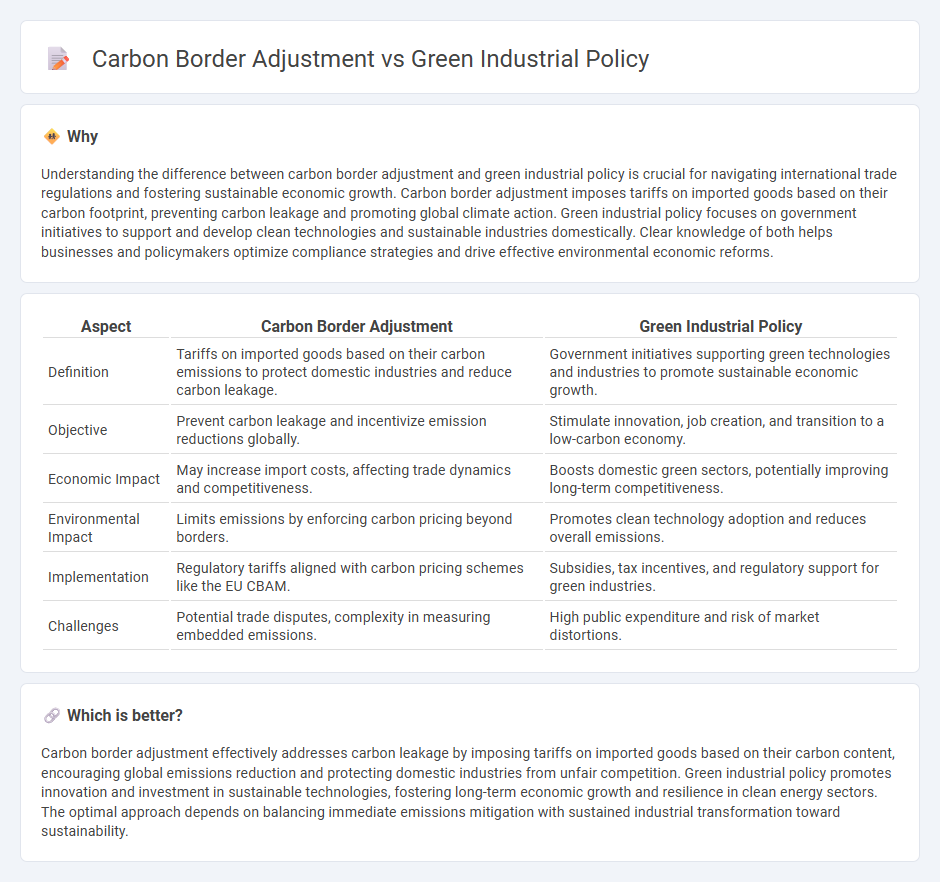
Carbon border adjustment mechanisms impose tariffs on imported goods based on their carbon emissions to level the playing field for domestic industries adhering to environmental regulations. Green industrial policies focus on stimulating innovation and investment in renewable energy and sustainable technologies to drive economic growth and reduce carbon footprints. Explore how these strategies shape global trade and environmental outcomes.
Why it is important
Understanding the difference between carbon border adjustment and green industrial policy is crucial for navigating international trade regulations and fostering sustainable economic growth. Carbon border adjustment imposes tariffs on imported goods based on their carbon footprint, preventing carbon leakage and promoting global climate action. Green industrial policy focuses on government initiatives to support and develop clean technologies and sustainable industries domestically. Clear knowledge of both helps businesses and policymakers optimize compliance strategies and drive effective environmental economic reforms.
Comparison Table
| Aspect | Carbon Border Adjustment | Green Industrial Policy |
|---|---|---|
| Definition | Tariffs on imported goods based on their carbon emissions to protect domestic industries and reduce carbon leakage. | Government initiatives supporting green technologies and industries to promote sustainable economic growth. |
| Objective | Prevent carbon leakage and incentivize emission reductions globally. | Stimulate innovation, job creation, and transition to a low-carbon economy. |
| Economic Impact | May increase import costs, affecting trade dynamics and competitiveness. | Boosts domestic green sectors, potentially improving long-term competitiveness. |
| Environmental Impact | Limits emissions by enforcing carbon pricing beyond borders. | Promotes clean technology adoption and reduces overall emissions. |
| Implementation | Regulatory tariffs aligned with carbon pricing schemes like the EU CBAM. | Subsidies, tax incentives, and regulatory support for green industries. |
| Challenges | Potential trade disputes, complexity in measuring embedded emissions. | High public expenditure and risk of market distortions. |
Which is better?
Carbon border adjustment effectively addresses carbon leakage by imposing tariffs on imported goods based on their carbon content, encouraging global emissions reduction and protecting domestic industries from unfair competition. Green industrial policy promotes innovation and investment in sustainable technologies, fostering long-term economic growth and resilience in clean energy sectors. The optimal approach depends on balancing immediate emissions mitigation with sustained industrial transformation toward sustainability.
Connection
Carbon border adjustment mechanisms impose tariffs on imported goods based on their carbon emissions, incentivizing cleaner production globally and leveling the playing field for domestic industries adhering to stringent environmental standards. Green industrial policy supports this objective by promoting sustainable technologies, renewable energy investments, and low-carbon innovation within domestic markets. Together, these strategies drive decarbonization, enhance competitiveness in green sectors, and align trade policies with climate goals.
Key Terms
Decarbonization
Green industrial policies prioritize local clean technology development and renewable energy adoption to accelerate decarbonization and economic resilience. Carbon border adjustments impose tariffs on imported goods based on their carbon footprint to level the playing field and incentivize global emissions reduction. Explore how these strategies complement each other in achieving comprehensive decarbonization goals.
Trade competitiveness
Green industrial policy aims to boost domestic industries by incentivizing clean technologies and sustainable production methods, enhancing trade competitiveness in emerging low-carbon markets. Carbon Border Adjustment Mechanisms (CBAM) impose tariffs on imported goods based on their carbon content to level the playing field for domestic producers facing strict climate regulations, protecting against carbon leakage and unfair trade advantages. Explore how these strategies impact global trade dynamics and influence competitive positioning in the transition to a low-carbon economy.
Emissions leakage
Green industrial policy aims to reduce emissions leakage by promoting domestic clean energy technologies and enforcing stricter environmental regulations within industries. Carbon border adjustment mechanisms mitigate emissions leakage by imposing tariffs on imported goods based on their carbon footprint, leveling the playing field for local industries adhering to climate regulations. Explore the nuances between these strategies to better understand their impact on global carbon emissions and trade dynamics.
Source and External Links
Green industrial policy - Wikipedia - Green industrial policy (GIP) is a strategic government approach aimed at accelerating the growth of green industries to transition to a low-carbon economy by addressing market failures, investment risks, and fostering sustainable and technological transformation.
The Green Deal Industrial Plan - European Commission - The EU's Green Deal Industrial Plan focuses on enhancing the competitiveness of Europe's net-zero industries by simplifying regulations, accelerating funding, and securing critical raw materials to advance the green transition and climate neutrality.
How to build and fund a better EU green industrial policy - Effective green industrial policy in the EU requires selective support for sectors with competitive potential and broad-based, firm-neutral policies such as increased R&D investment and infrastructure development to avoid inefficiencies and regulatory capture.
 dowidth.com
dowidth.com